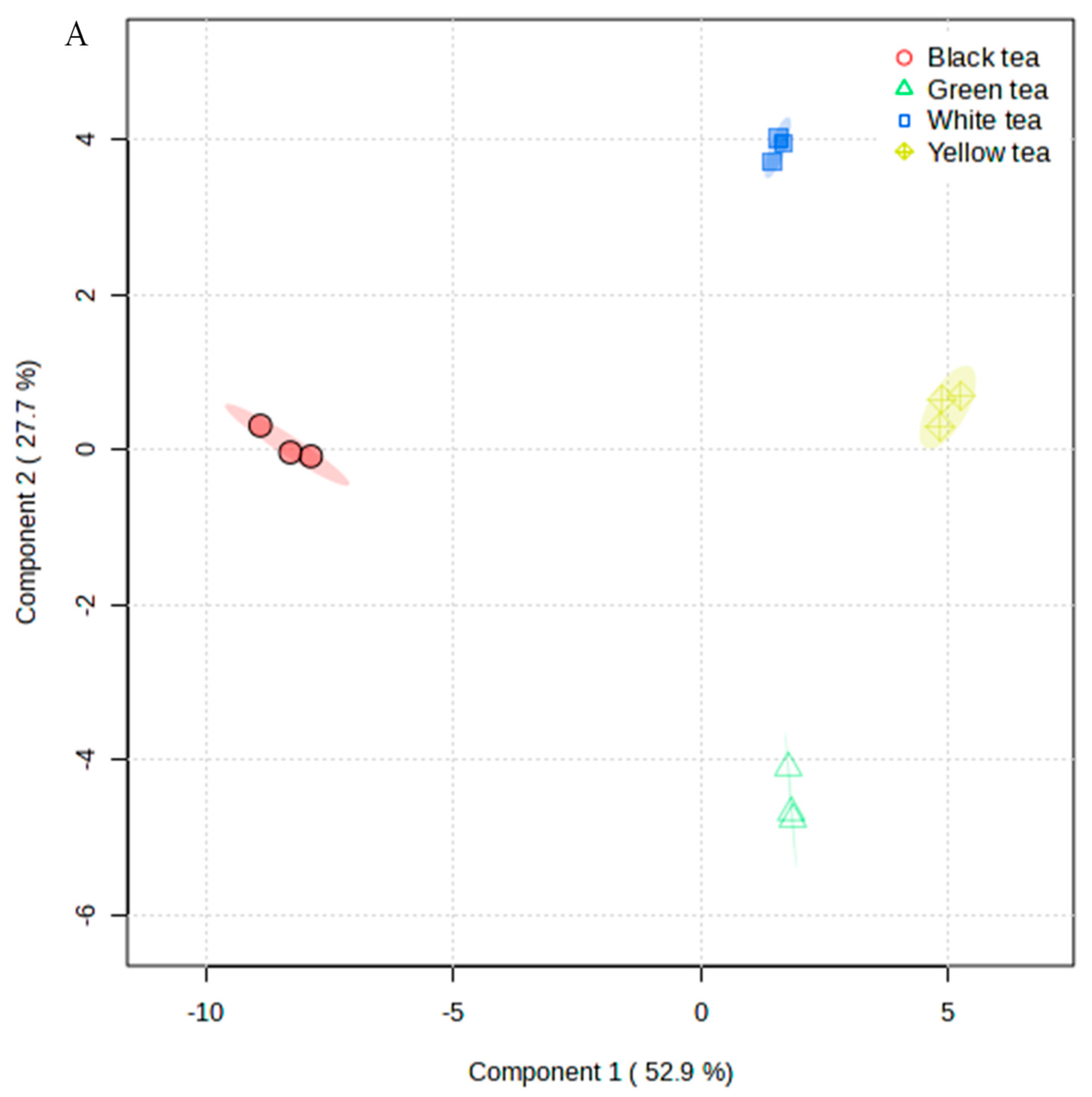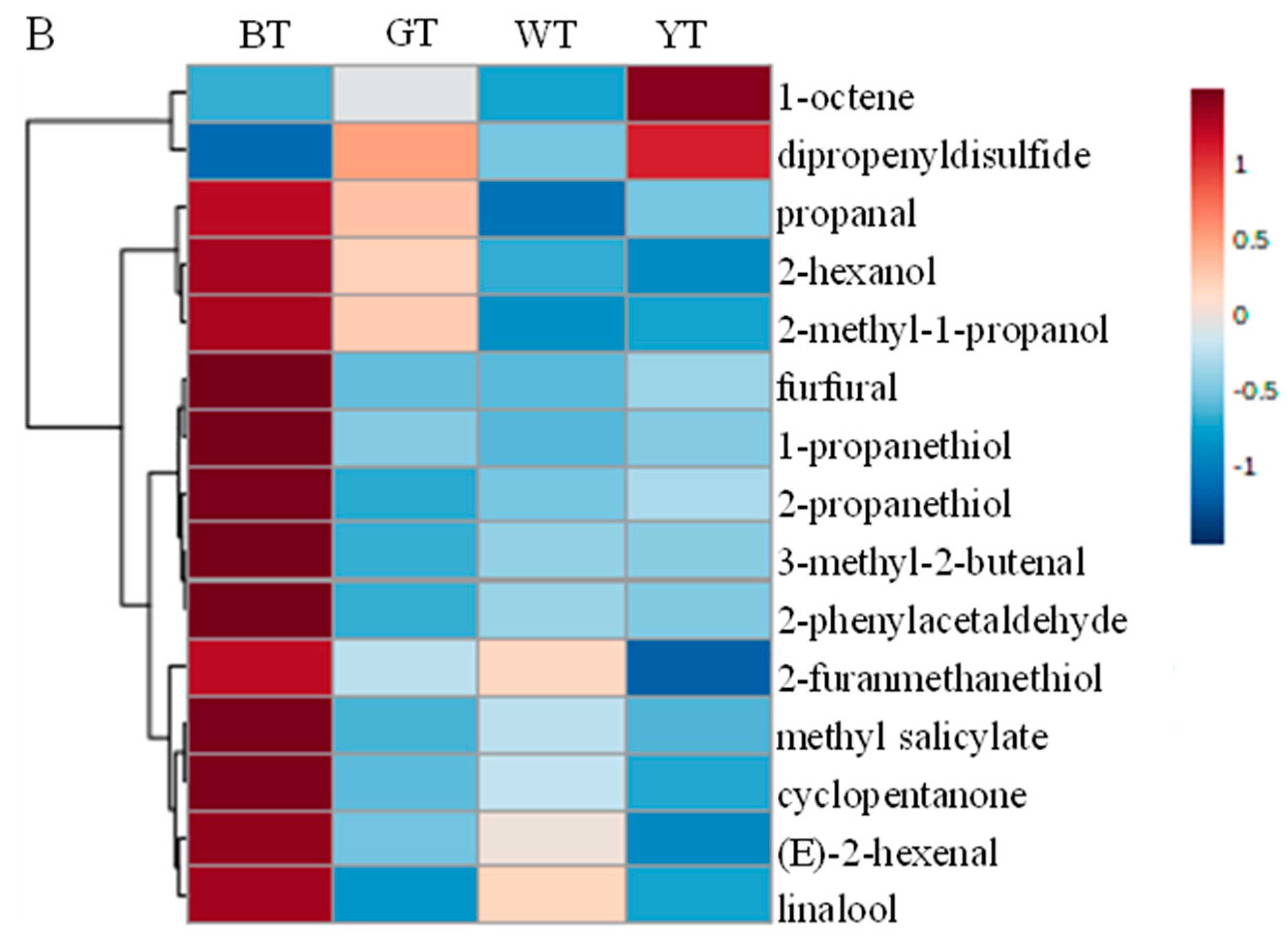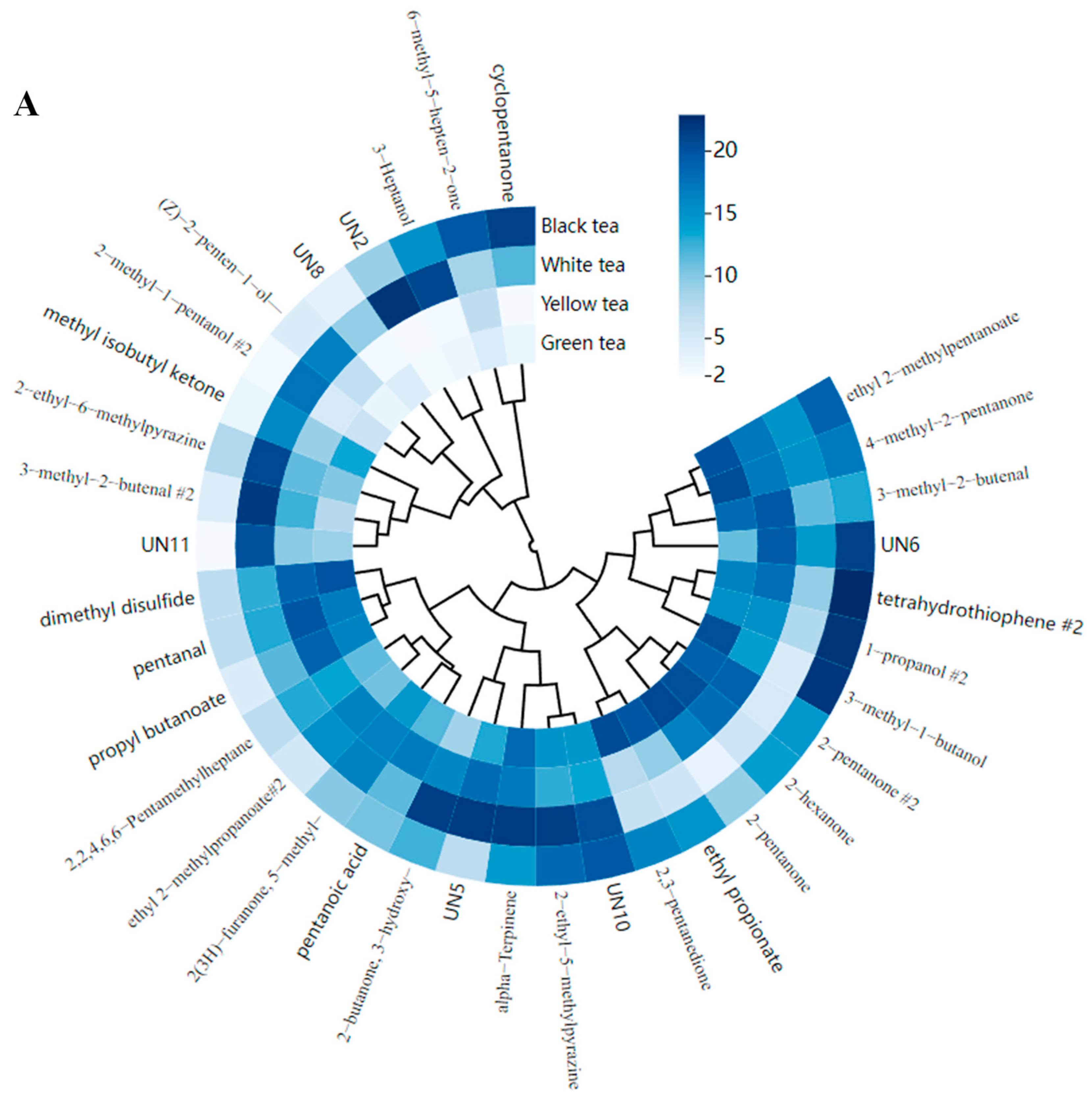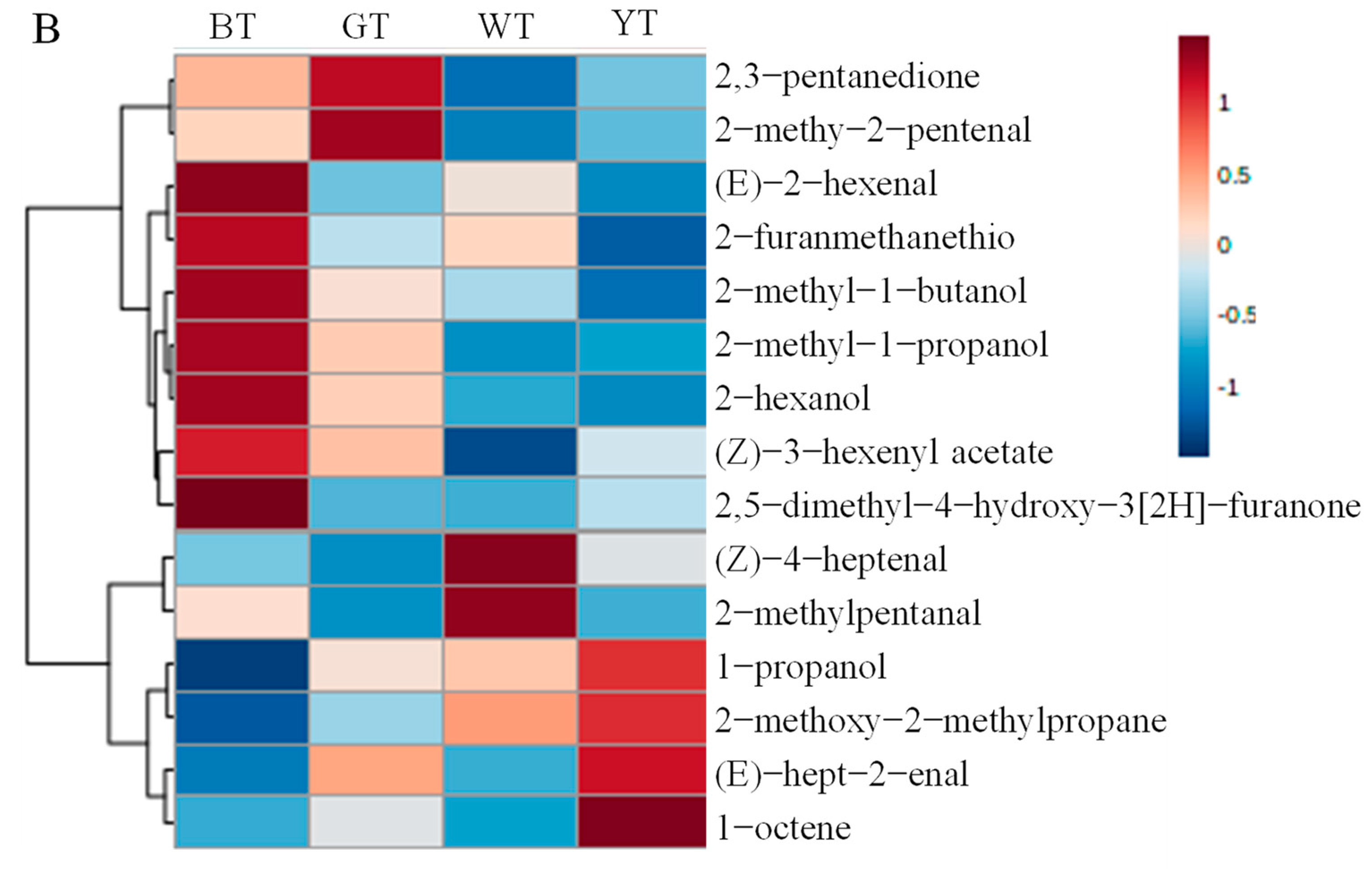Comparison of Volatile Compounds among Four Types of Teas Analyzed Using Gas Chromatography–Ion Mobility Spectrometry
Abstract
1. Introduction
2. Materials and Methods
2.1. Tea Plant Material and Chemicals
2.2. Methods
2.2.1. Tea Sample Manufacture
2.2.2. Sense-Based Quality Valuation
2.2.3. Analysis of Volatile Compounds
2.2.4. Data Processing
3. Results and Discussion
3.1. Profiles of the Volatile Compounds of Tea Samples
3.2. Four Types of Teas Distinguished according to Volatile Compound Content
3.3. Comparison of Volatile Compounds among Four Types of Teas
3.3.1. Main Components
3.3.2. Common Components
3.3.3. Differential Components
4. Conclusions
Supplementary Materials
Author Contributions
Funding
Institutional Review Board Statement
Informed Consent Statement
Data Availability Statement
Conflicts of Interest
References
- Yin, H.X.; Yang, Y.Q.; Yao, Y.F.; Zhang, M.M.; Jiang, Y.W.; Yuan, H.B. Optimization of aroma extraction and aroma component analysis on chestnut-like green tea. J. Tea Sci. 2018, 38, 518–526. [Google Scholar]
- Zhang, M.M.; Yang, Y.Q.; Yuan, H.B.; Hua, J.J.; Deng, Y.L.; Jiang, Y.W.; Wang, J.J. Contribution of addition theanine sucrose on the formation of chestnut-like. LWT 2022, 129, 109512. [Google Scholar] [CrossRef]
- Liu, N.F.; Shen, S.S.; Huang, L.F.; Deng, G.J.; Wei, Y.M.; Ning, J.M.; Wang, Y.J. Revelation of volatile contributions in green teas with different aroma types by GC–MS and GC–IMS. Food Res. Int. 2023, 169, 112845. [Google Scholar] [CrossRef]
- Togari, N.; Kobayashi, A.; Aishima, T. Pattern recognition applied to gas chromatographic profiles of volatile components in three tea categories. Food Res. Int. 1995, 28, 495–502. [Google Scholar] [CrossRef]
- Mao, S.H.; Lu, C.Q.; Li, M.F.; Ye, Y.L.; Wei, X.; Tong, H.R. Identification of key aromatic compounds in Congou black tea by partial least-square regression with variable importance of projection scores and gas chromatography-mass spectrometry/gas chromatography-olfactometry. J. Sci. Food Agric. 2018, 98, 5278–5286. [Google Scholar] [CrossRef] [PubMed]
- Fang, Q.T.; Luo, W.W.; Zheng, Y.N.; Ye, Y.; Hu, M.J.; Zheng, X.Q.; Lu, J.L.; Liang, Y.R.; Ye, J.H. Identification of key aroma compounds responsible for the floral ascents of green and black teas from different tea cultivars. Molecules 2022, 27, 2809. [Google Scholar] [CrossRef] [PubMed]
- Li, X.L.; Yu, X.M.; Gong, Z.H.; Lin, H.Z.; Hao, Z.L.; Zhang, Y.; Jin, X.Y. Difference in main metabolites contents in green tea, black tea, oolong tea and white tea. J. Fujian Agric. Fore. Uni. (Nat. Sci. Ed.) 2019, 48, 559–566. [Google Scholar]
- Peng, J.R.; Wen, L.X.; Zhang, F.; Chen, J.X.; Yuan, D.Y.; Ou, S.Q. Quality analysis of trial-processed different tea with Almond Tea Germplasm in Guangxi. Food Sci. 2023, 44, 291–297. [Google Scholar]
- Dai, W.D.; Xie, D.C.; Lu, M.L.; Li, P.L.; Lv, H.P.; Yang, C.; Peng, Q.H.; Zhu, Y.; Guo, L.; Zhang, Y.; et al. Characterization of white tea metabolome: Comparison against green and black tea by a nontargeted metabolomics approach. Food Res. Int. 2017, 96, 40–45. [Google Scholar] [CrossRef] [PubMed]
- Wang, S.Q.; Chen, H.T.; Sun, B.G. Recent progress in food flavor analysis using gas chromatography-ion mobility spectrometry (GC-IMS). Food Chem. 2020, 315, 126158. [Google Scholar] [CrossRef] [PubMed]
- Segura-Borrego, M.P.; Martin-Gomez, A.; Rios-Reina, R.; Cardador, M.J.; Morales, M.L.; Arce, L.; Callejon, R.M. A non-destructive sampling method for food authentication using gas chromatography coupled to mass spectrometry or ion mobility spectrometry. Food Chem. 2022, 373, 131540. [Google Scholar] [CrossRef] [PubMed]
- Jin, J.; Zhao, M.Y.; Zhang, N.; Jing, T.T.; Liu, H.T.; Song, C.K. Stable isotope signatures versus gas chromatography-ion mobility spectrometry to determine the geographical origin of Fujian oolong tea (Camellia sinensis) samples. Eur. Food Res. Technol. 2020, 246, 955–964. [Google Scholar] [CrossRef]
- Guo, X.Y.; Schwab, W.; Ho, C.T.; Song, C.K.; Wan, X.C. Characterization of the aroma profiles of oolong tea made from three tea cultivars by both GC–MS and GC-IMS. Food Chem. 2022, 376, 131933. [Google Scholar] [CrossRef] [PubMed]
- Yang, Y.Q.; Qian, M.C.; Deng, Y.L.; Yuan, H.B.; Jiang, Y.W. Insight into aroma dynamic changes during the whole manufacturing process of chestnut-like aroma green tea by combining GC-E-Nose, GC-IMS, and GC×GC-TOFMS. Food Chem. 2022, 387, 132813. [Google Scholar] [CrossRef] [PubMed]
- Jin, X.F.; Cao, D.; Ma, L.L.; Gon, Z.M.; Jia, S.Z. Study on regional adaptability of ten clonal green Tea Cultivars. Hubei Agric. Sci. 2015, 54, 5934–5936. [Google Scholar]
- Chen, H.Y.; Zhang, X.M.; Jiang, R.G.; Ou, Y.J.; Liu, Q.; Li, J.; Wen, H.T.; Li, Q.; Chen, J.H.; Xiong, L.G.; et al. Characterization of aroma differences on three drying treatments in Rucheng Baimao (Camellia pubescens) white tea. LWT 2023, 179, 114659. [Google Scholar] [CrossRef]
- Chen, Q.C.; Zhu, Y.; Yan, H.; Chen, M.; Xie, D.C.; Wang, M.Q.; Ni, D.J.; Lin, Z. Identification of aroma composition and key odorants contributing to aroma characteristics of white teas. Molecules 2020, 25, 6050. [Google Scholar] [CrossRef] [PubMed]
- Luo, Y.Q.; Wei, Y.J.; Lin, L.; Lin, F.M.; Su, F.; Sun, W.J. Origin discrimination of Fujian white tea using gas chromatography-ion mobility spectrometry. Trans. CSAE 2021, 37, 264–273. [Google Scholar]
- Wang, L.; Cai, L.S.; Lin, Z.; Zhong, Q.S.; Lv, H.P.; Tang, J.F.; Guo, L. Analysis of aroma compounds in white tea using headspace solid-phase micro-extraction and GC-MS. J. Tea Sci. 2010, 30, 115–123. [Google Scholar]
- Lin, J.Z.; Liu, F.; Zhou, X.F.; Tu, Z.; Chen, L.; Wang, Y.W.; Yang, Y.F.; Wu, X.; Lv, H.W.; Zhu, H.K.; et al. Effect of red light on the composition of metabolites in tea leaves during the withering process using untargeted metabolomics. J. Sci. Food Agric. 2022, 102, 1628–1639. [Google Scholar] [CrossRef] [PubMed]
- Shan, X.J.; Deng, Y.L.; Niu, L.C.; Chen, L.; Zhang, S.; Jiang, Y.W.; Yuan, H.B.; Wang, Y.J.; Li, J. The influence of fixation temperature on Longjing tea taste profile and the underlying non-volatile metabolites changes unraveled by combined analyses of metabolomics and E-tongue. LWT 2023, 191, 115560. [Google Scholar] [CrossRef]
- Tao, M.; Guo, W.L.; Zhang, W.J.; Liu, Z.Q. Characterization and quantitative comparison of key aroma volatiles in fresh and 1-year-stored keemun black tea infusions: Insights to aroma transformation during Storage. Food 2022, 11, 628. [Google Scholar] [CrossRef] [PubMed]
- Bae, J.; Kumazoe, M.; Fujimura, Y.; Tachibanna, H. Diallyl disulfide potentiates anti-obesity effect of green tea in high-fat/high-sucrose diet-induced obesity. J. Nutr. Biochem. 2019, 64, 152–161. [Google Scholar] [CrossRef] [PubMed]
- Guo, L.; Chen, M.J.; Guo, Y.L.; Lin, Z. Variations in fatty acids affected their derivative volatiles during Tieguanyin tea processing. Food 2022, 11, 1563. [Google Scholar] [CrossRef] [PubMed]
- Dong, R.J.; Sheng, X.H.; Xie, Q.T.; Huang, X.L.; Yan, F.J.; Liu, S.B. Aroma formation and transformation during sealed yellowing process of Pingyang yellow tea. Food Res. Int. 2023, 165, 112535. [Google Scholar] [CrossRef] [PubMed]
- Shen, S.S.; Wu, H.T.; Li, T.H.; Sun, H.R.; Wang, Y.J.; Ning, J.M. Formation of aroma characteristics driven by volatile components during long-term storage of An tea. Food Chem. 2023, 411, 135487. [Google Scholar] [CrossRef] [PubMed]
- Shi, Y.L.; Wang, M.Q.; Dong, Z.B.; Zhu, Y.; Shi, J.; Ma, W.J.; Lin, Z. Volatile components and key odorants of Chinese yellow tea (Camellia sinensis). LWT 2021, 146, 111512. [Google Scholar] [CrossRef]
- Huang, W.J.; Fang, S.M.; Wang, J.; Zhuo, C.; Luo, Y.H.; Yu, Y.L.; Li, L.Q.; Wang, Y.J.; Deng, W.W.; Ning, J.M. Sensomics analysis of the effect of the withering method on the aroma components of Keemun black tea. Food Chem. 2022, 395, 133549. [Google Scholar] [CrossRef] [PubMed]





Disclaimer/Publisher’s Note: The statements, opinions and data contained in all publications are solely those of the individual author(s) and contributor(s) and not of MDPI and/or the editor(s). MDPI and/or the editor(s) disclaim responsibility for any injury to people or property resulting from any ideas, methods, instructions or products referred to in the content. |
© 2024 by the authors. Licensee MDPI, Basel, Switzerland. This article is an open access article distributed under the terms and conditions of the Creative Commons Attribution (CC BY) license (https://creativecommons.org/licenses/by/4.0/).
Share and Cite
Guo, L.; Xie, C.; Zhao, F.; Zhang, Y.; Lin, Z. Comparison of Volatile Compounds among Four Types of Teas Analyzed Using Gas Chromatography–Ion Mobility Spectrometry. Foods 2024, 13, 2043. https://doi.org/10.3390/foods13132043
Guo L, Xie C, Zhao F, Zhang Y, Lin Z. Comparison of Volatile Compounds among Four Types of Teas Analyzed Using Gas Chromatography–Ion Mobility Spectrometry. Foods. 2024; 13(13):2043. https://doi.org/10.3390/foods13132043
Chicago/Turabian StyleGuo, Li, Chenxi Xie, Feng Zhao, Yue Zhang, and Zhi Lin. 2024. "Comparison of Volatile Compounds among Four Types of Teas Analyzed Using Gas Chromatography–Ion Mobility Spectrometry" Foods 13, no. 13: 2043. https://doi.org/10.3390/foods13132043
APA StyleGuo, L., Xie, C., Zhao, F., Zhang, Y., & Lin, Z. (2024). Comparison of Volatile Compounds among Four Types of Teas Analyzed Using Gas Chromatography–Ion Mobility Spectrometry. Foods, 13(13), 2043. https://doi.org/10.3390/foods13132043






